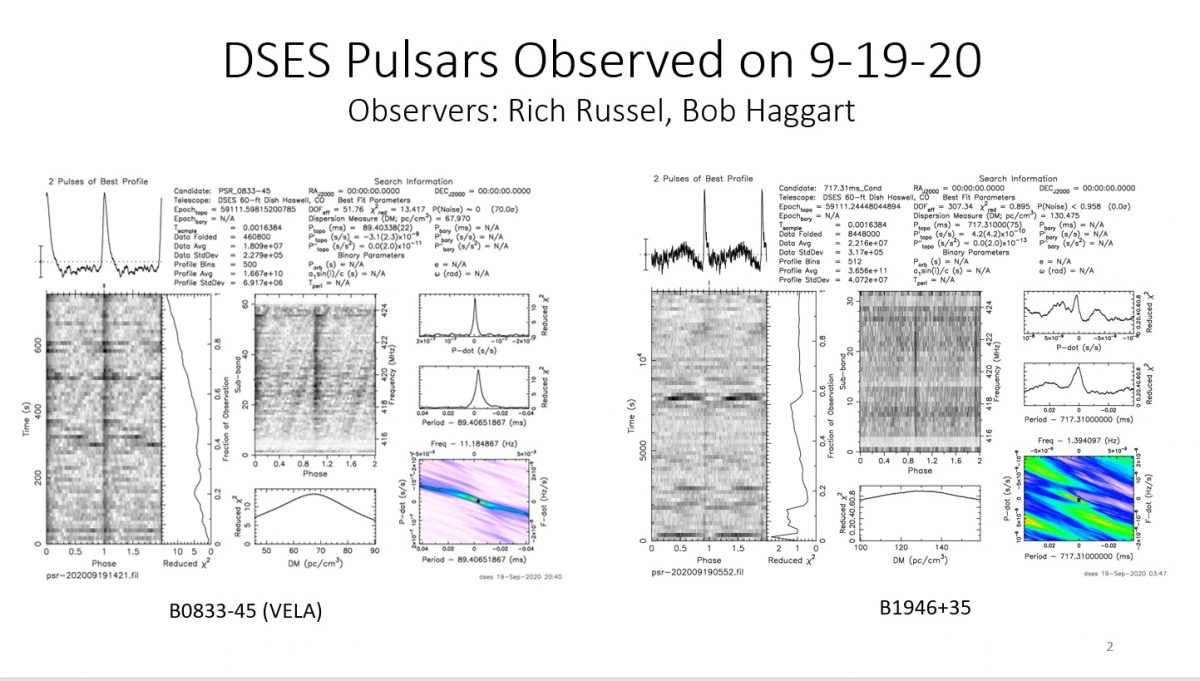Bob Haggart and Rich Russel did an observation all nighter on Friday/Saturday (September 19, 2020, GMT) and observed 2 pulsars.
VELA (B0833-45) is one of the strongest pulsars at 5 JY while B1946+35 is at 0.145 JY.
DSES is one of the most northern amateur stations to detect VELA. We detected it in 15 minutes at 5 to 6 degrees elevation.
This make 13 pulsars and puts us 5th on the international amateur pulsar hunter list. http://www.neutronstar.joataman.net/
Category: Science
DSES Pulsar Observing Team netted 5 new pulsars!
The DSES team of Rich Russel, Ray Uberecken, and Glenn Davis observed for pulsars on Saturday September 5, 2020 at the DSES 60-foot dish antenna at Haswell, CO.
The team successfully observed 5 pulsars which we hadn’t been able to detect before.
The success is attributed to the calibration of the antenna pointing system and the new automatic tracking system developed by the System 1 team.
We started with calibrating the azimuth of the antenna (it was 2.5 degrees off!) Elevation was good. Glenn put the offset in the auto tracking system and we were able to detect the B0329+54 pulsar within 30 minutes. (We use the B0329+54 pulsar, the first one we successfully saw last May, as a starting reference. If we can observe this, we know our system is working.) Every pulsar we looked at after that was detected – we just ran out of time for more!
It is possible we missed observing previous pulsars because our pointing accuracy was off.
See the slide set for our observation summary.
http://dses.science/wp-content/uploads/2020/09/8-Pulsars-Observed-so-Far-9-5-20-r3.pdf
We are pretty sure we observed the Crab pulsar. The last slide shows an analysis of the time between pulses we measured for the Crab pulsar, compared to the standard reference database.
More detail to come at the next science meeting
Our total pulsar count is now 8!
DSES Science Meeting, August 24, 2020
These are the slides from our online Science meeting, on August 24, 2020. The meeting was hosted by our DSES Science Lead, Rich Russel,
http://dses.science/wp-content/uploads/2020/08/DSES-Science-Meeting-8-24-20.pdf
You can watch the video of our meeting:
2020 Society of Amateur Radio Astronomers Eastern Conference Videos
Videos of all of the presentations at the 2020 Society of Amateur Radio Astronomers Eastern Conference are now available online at the SARA website. The conference was held on August 1 & 2, 2020.
The SARA page is organized so that you can reach each presentation individually. The videos are carried on YouTube.
https://www.radio-astronomy.org/node/331
Nominally the Eastern Conference is held each year at the Green Bank Observatory in West Virginia. This year the conference was carried completely online using Zoom. The coordinator for this conference was our own DSES Science Lead, Richard Russel. Over 93 SARA members participated, including several DSES members. DSES members Ray Uberecken, Skip Crilly, and Rich Russel gave talk presentations. Rich also was elected as Vice President of SARA.
2020-07-27 DSES Science Meeting Notes
Welcome to the July DSES Science meeting 7/27/2020
2020-07-27 DSES Science Meeting Notes: by Bill Miller
We had 14 participants in the virtual science meeting today: Thanks everyone for joining.
Participants: Dr. Rich Russel, Ray Uberecken, Ted Cline, Jonathan Ayers, Ed Corn, Gary Agranat, Glenn Davis, Jim Madsen, Bob Haggart, Jon Richardson, Dave Schick, Don Latham, Tony Bigbee, Bill Miller
Agenda and notes; See the Zoom Recording for more detail: https://us02web.zoom.us/rec/share/u50vfrXt12hJbKf341OCGbJmA8fIaaa80ylL-
- Discussion of needed policy on site installs and changes
- We have had a number of site conflicts of late. These have resulted in a lot of waisted installation and observation time and frustration as well as hard feelings between members and damage to the dish, and operations center.
- General Proposal: I have often said that if you see something that needs improvement and you have the skill to do it, take it on and just do it. We need to qualify that with a little more process. In order to improve the site, equipment and observation capability and move the organization forward we often need to make changes. The Engineering meeting is where we coordinate and plan for these changes. If not previously planned and you are on site and need to make a change to a significant system you must call the person who installed or last modified that system and discuss it with them prior to removing, modifying or replacing it.
- Use the Engineering Meeting for what it was intended.
- Be considerate and helpful to each other.
- Communication and coordination of equipment changes should not be a problem and further conflicts will have to be dealt with.
- We will need to repair the damage.
- We all have a common goal to improve the facility and equipment. Let’s not have these issues. When in doubt, Ask.
- We will potentially have photographers on site Thursday or Saturday for comet picture opportunity. Would like to have a member on site to give access and keep the photographers out of trouble. Any volunteers?
- Don Savage don.savage54 (at) gmail.com is coordinating 4 or 5 night sky photographers.
- We will have them sign a Liability Waver
- July-August Events:
- The SARA virtual Eastern Conference will be held on Saturday and Sunday the 1st and 2nd of August. See the SARA web site for info and payment.
- Comet C/2020 F3 (NEOWISE) is currently in the constellation of Ursa Major. The current Right Ascension is 11h 45m 40s and the Declination is +36° 12’ 10”
- Additional pulsar observations. Please post planned dates and attendance
- Additional SETI Observations. Please post planned dates and attendance.
- Open house is cancelled for CoVid19, but we may do a small member camp out if some members would be interested in that.
- We will also assemble a virtual Open House presentation for various usage such as public outreach, education, fundraising and general interest.
- The Perseids will peak on Aug 11-12. On these nights, the moon will be 47% full.
- The next dark sky moon phase is Aug 13th through Aug 21.
- Glenn gave an overview of what was done recently on the System 1 Automatic Tracking HW and SW. New features include:
- Automatic Tracking
- RA and Dec track automatically
- Az/El position command
- Track Moon Command
- Stow command
Tracking stayed within the bore site during the whole 5 hr. evening session.
Need to do more training, Glenn and his wife will go to the site tomorrow and draw up a training presentation and checklist.
Needs:
- Sun exclusion track but there is a pop up on the screen that you are in the sun exclusion area.
- It would be nice to have a Raster Scan capability to map Object Hi Emissions and to help pointing accuracy.
- Rich provided his presentation on Pulsar, Fast Radio Burst and other experiments and observation we can do.
5. Rich gave high praise and kudos to the System 1 team to get a very high quality tracking and control complete. Very clean system design and implementation from Glenn Davis, Lewis Putnam and Phil Gage. Much praise.
Discussion/presentation on Pulsar and other science topics from Dr. Richard Russel
See the attached presentation: http://dses.science/wp-content/uploads/2020/07/DSES-Science-Meeting-7-27-20.pdf
See the Zoom recording for more detail.
https://us02web.zoom.us/rec/share/u50vfrXt12hJbKf341OCGbJmA8fIaaa80ylL-aUKzx2QbQXjO1w8ndJvEt-SL86-
Deep Space Exploration Society 3rd pulsar observed on Saturday July 11, 2020
By Dr. Richard Russel, DSES Science Lead
The pulsar, B1133+16, was observed on the 60 ft dish antenna by Rich Russel and Ray Uberecken after 4 hours of tracking and collecting data on the pulsar.
This pulsar is the weakest object observed by DSES at 0.257 Janskys!
The pulsar is noted for having a “conal double” peak in its profile. Our observation picks this out very well.
The PRESTO analysis program results are shown below.
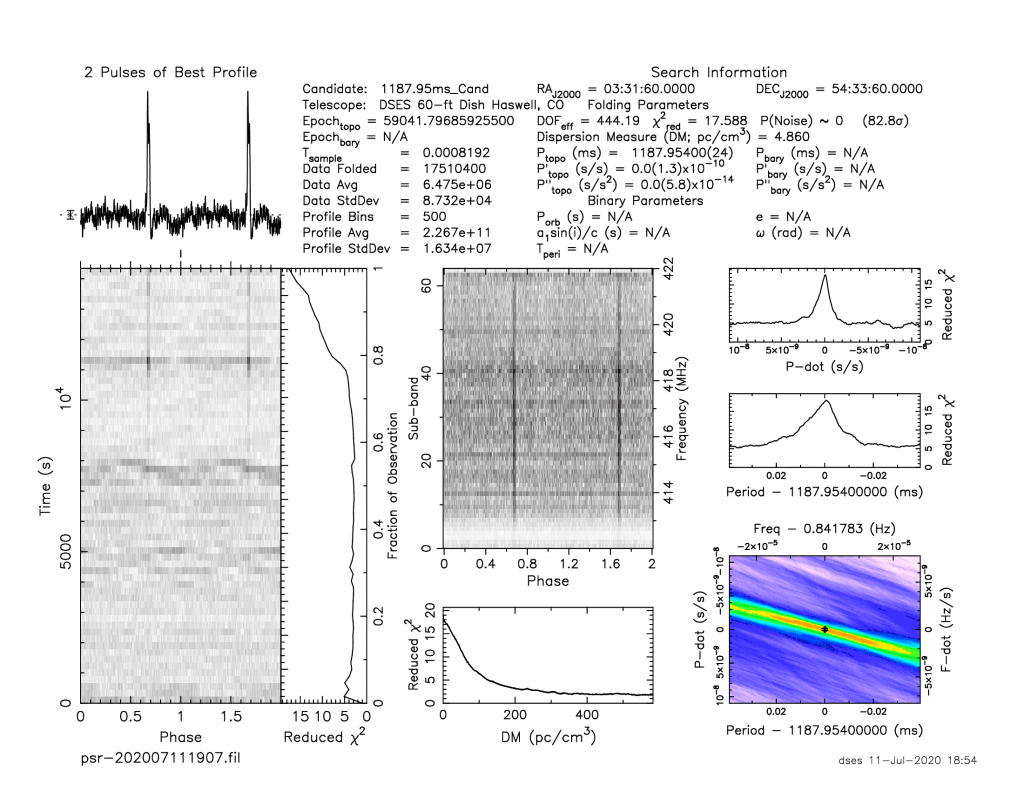
The conal double plot is produced from the raw data and plotted in excel.

PSR B1133+16 is located at RA 11h 33m 27s Declination +16.07°, in the northeast part of the constellation Leo. It was observed with a pulse period of 1.187 seconds. Our center frequency was 417 MHz, and we used a 10 MHz bandwidth.
(The name B1133+16 conveys the celestial sky coordinates, referenced to a standard year epoch. In this case the B indicates the position is from the year 1950, the “Besselian” year, named after the German astronomer Friedrich Bessel.)
Congratulations to the entire membership for turning the DSES dish into a world class scientific instrument!
Thanks!
Dr. Richard Russel
DSES Science Lead
“Our second confirmed pulsar!”
Rich Russel reports we observed our second confirmed pulsar, “We got B0950+08 today!!!!!!” The observing team was Rich Russel, Ray Uberecken, and Bob Haggart. The team did the observing and made the measurement at the Plishner radio telescope site with the 60-foot antenna yesterday on July 4, 2020. Congratulations to the team! And congratulations are due also to all of the DSES members who have been working hard to restore the 60-foot dish antenna and develop is capability as a working scientific tool! This is a long time coming.
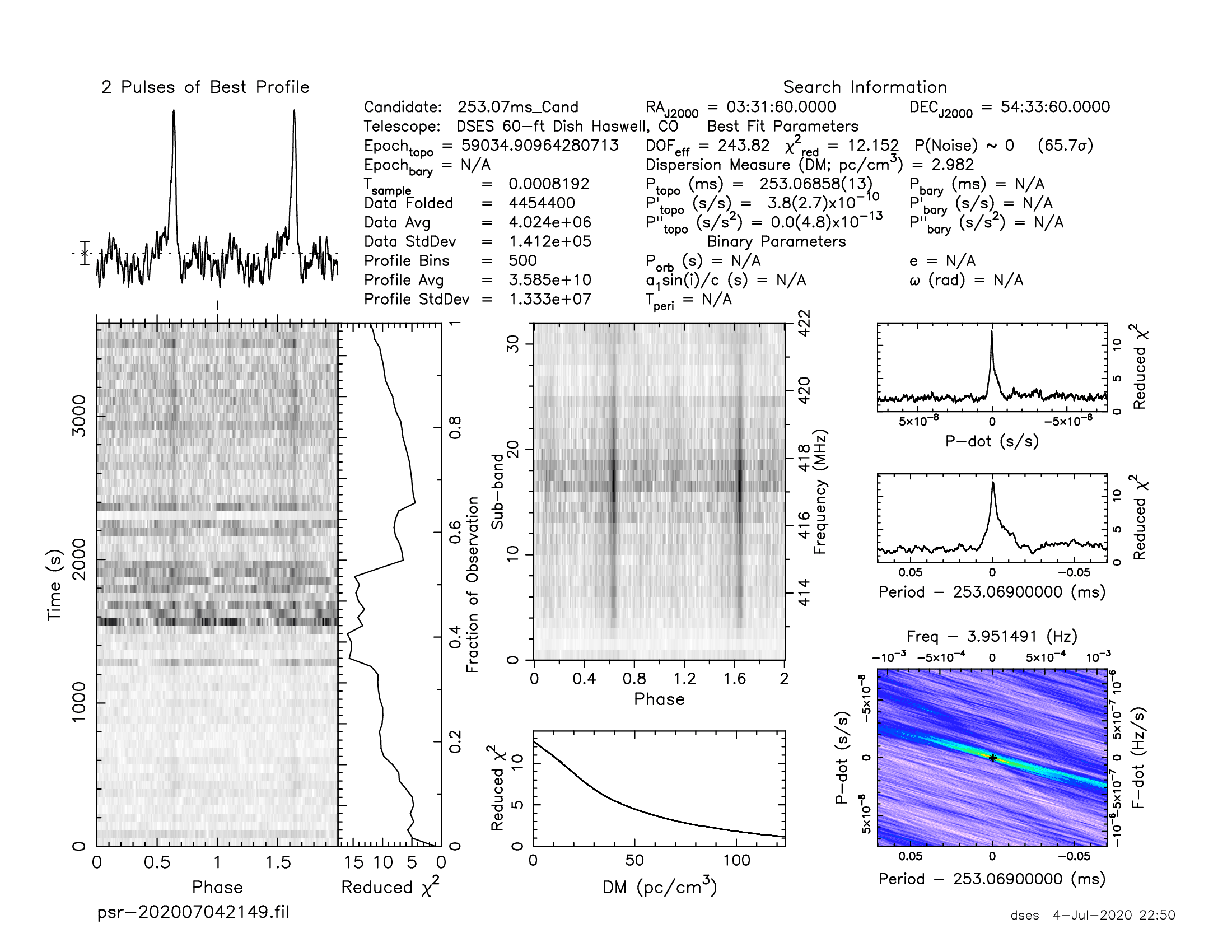
A brief information entry about PSR B0950+08 in Wikipedia: https://en.wikipedia.org/wiki/PSR_B0950+08
Meanwhile, the report of our first pulsar observation on May 2nd, of pulsar, B0329+54 (J0332+5434), was just published in the May-June journal of the Society of Amateur Radio Astronomers: First Deep Space Exploration Society (DSES) Pulsar Captured on the 60-ft Dish
DSES Science Meeting June 22, 2020
2020-06-22 DSES Science Meeting
Notes by Bill Miller.
Science Presentation by Dr. Rich Russel.
Participants:
We had 19 participants in the virtual science meeting, a new record.
Dr. Rich Russel, Ray Uberecken, Myron Babcock, Don Latham, Bascombe Wilson, Ted Cline, Jon Richardson KU4PEH, Ed Corn, Storm Quant (Kevin Shoemaker), Jay Wilson, Glenn Davis, Gary Agranat, Dave Molter, Dave Schick, Bob Haggart, Jim Madsen K3ILC, Bob Sayers, Tony Bigbee, Bill Miller
Preliminaries:
Plishner site trip summary of 6-20-20:
Ray Uberecken , Bob Haggart and Bill Miller went to the Plishner site on Sat. June 20. See notes in Site trip report.
Covid-19 Policy:
Once again, we want to remind everyone to read our policy on Covid-19 on the webpage concerning meeting and going to the site. In summary; If you have had the virus or have had symptoms or been closely exposed to a positive person you should let us know and self-isolate from the group and others for 14 days and not meet of go to the site.
SARA east conference
Rich is the SARA east conference coordinator. The August conference is virtual and is $20 to participate on Sat-Sun Aug 1st and 2nd.
Rich’s science presentation on Pulsar detection:
http://dses.science/wp-content/uploads/2020/06/DSES-Science-Meeting-6-22-20.pdf
Much of the discussion was focused on understanding our pulsar observation and on what we can do improve our ability.
Zoom Meeting Recording
Date: Jun 22, 2020 05:08 PM Mountain Time (US and Canada)
https://us02web.zoom.us/rec/share/5MlUEJfO0F5LXbPd2WvWeP4fRb-_eaa80SgYq6JYnhmJ9zhQ6vhRNDmHd4LZkX0-
Password: 9x@t3pt*
Deep Space Exploration Society Science Meeting – May 25, 2020
Hosted online by Dr. Richard Russel.
The slides for the meeting are available here on PDF: http://dses.science/wp-content/uploads/2020/05/DSES-Science-Meeting-5-25-2020-r2.pdf
The link to the video of the meeting is at the end of this page.
*
Notes of the May 25, 2020 Science Meeting are by Bill Miller:
We had 12 participants in the virtual science meeting:
Dr. Rich Russel, Ray Uberecken, Myron Babcock, Ted Cline, Jon Richardson KU4PEH, Ed Corn, Gary Agranat, Bob Haggart, Jim Madsen K3ILC, Dave Molter, Bill Miller
Preliminaries:
Rich thinks we need Internet service at the site for some of the experiments.
When Rich and Ray went down this last weekend the transformer at the gate had blown and they had to call in the power company to come fix it so didn’t get anything else done. The power company came down, worked on it, and got it fixed.
Bill, we need to mention that everyone should read our policy on meeting and going to the site on the webpage. If you have had the virus or have had symptoms or been exposed to a positive person you should self-isolate from the group and others for 14 days and not meet of go to the site.
Rich is the SARA east conference coordinator. The August conference is virtual and is $20 to participate. http://www.radio-astronomy.org/node/279
We were placed on the Neutron star group for the pulsar observation that Rich, Ray and Bob made several weeks ago. Rich thanks the rest of the group for all the hard work that got us to this point.
http://neutronstar.joataman.net/sites/dses/index.html
Rich’s presentation:
Rich gave his presentation on Pulsar B0329+54 observation, software setup and capture.
- We had a lot of help from Steve Plock and Dr. Joe Martin (K5SO) to set up the SDR.
- All the team members have put in a great deal of time and travel into the observatory to set up the feeds, cabling, power and control system to do this.
- Ray, Bob and Rich were there for the first pulsar capture but everyone contributed.
- Used the Ettus Research USRP N210 receiver.
- Used a specially configured Laptop with a 1TB drive, Linux and Presto SW.
- Used the GNU SW by Dr. Joe Martin (K5SO).
The Presto SW builds a .FIL file with the data and time stamp.
Initial trial runs in Feb and May had the gain set too high and was saturating the receiver.
The first thing to check is the signal level of the feed and amps on a spectrum analyzer.
The site has a lot of RFI at 408 MHz right where we would like to observe so have to move up from this.
Ray added a 20dB preamp at the trailer end of the feed line.
Will move this preamp to the antenna end to compensate for the coax loss and reduce noise.
Single frequency RFI signals are filtered out by the SW.
The manual tracking works really well.
The tracking is run on the control Laptop and the Presto SW is run on the Linux Laptop.
The Initial .FIL file gave a 2 pulse display after folding the signal from several hours of data.
The Presto SW is at www.cv.nrao.edu/~sransom/presto
The SW needs input of a very accurate pulsar period. The doppler error in the period due to the rotation of the earth and its orbital velocity and position in orbit, also modifies the perceived pulsar period. Need to have the pulsar period set out to 4 or 5 decimals for the SW to fold/stack the signals to a usable observation.
The new SW takes the data, time tags it with the GPS data and creates the .FIL file.
The data from the Presto program will give a signal strength vs time for a single pulse that can be plotted using excel. This Pulsar has a W50, 50% of pulse height with width of 6.6 mSec
This pulsar is circumpolar so it can be acquired at any time of day. We need to change the mount limits to better enable this tracking without having to stop and unwrap 360 degrees if near the stop.
Most of the other available pulsars are in the Milky Way and only visible at night at this time of year.
The Murmur SW http://i0naa.Altervista.org is a good tool to find the pulsars
For low horizon pulsars with little access time, perhaps you could add the sample files from several days together to get more data and stacking strength to acquire the signal.
Scintillation is a problem that distorts the signal through the atmosphere so we need observations that are high in elevation and at the best times of day and night for atmospheric stability.
The next observing session is planned for coming Friday night or through Saturday.
We need to get at least 5 pulsars to get on the top of the neutron star list.
Jon asked, “Where is the pulsar capability going?”
Badge of honor and accomplishment.
One of the difficult things we have the facility to do.
Finding a glitch in the pulsar.
There are guys that process pulsars daily and look for anomalies.
Ray has his new quick change feed on the dish.
We can do pulsars for several months and then do EME or can receive the beacon from the moon.
https://www.google.com/search?q=OE5JFL+beacon
With Rays quick change feed, we can switch back and forth.
We can do Skips SETI observations in between other work with simple change out of the feeds.
We need a group calendar or way to communicate on the web site to schedule site trips and who is going. Need to find a way to do this.
The Zoom Meeting Recording can be found on my Drop Box link at:
https://www.dropbox.com/sh/l949mj9o2084nhs/AACnrJNys-jzNa-mwzSfG4eka?dl=0&preview=2020-05-25+Science+Meeting.mp4
Please forgive the first 5 minutes of setting up Zoom.
First DSES Pulsar captured on the 60-ft dish by the observing team of Richard A. Russel, Ray Uberecken, Bob Haggart On May 2, 2020
By Dr. Richard Russel, DSES Science Lead.
The pulsar, B0329+54 (J0332+5434)1, was observed on the third try just before the team was ready to pack up for the day on Saturday, May 2, 2020. A final modification of the software defined radio settings was tried (all the gains were set to a minimum) did the trick.
The 60-ft dish was setup to manually track the pulsar using the System 1 tracking program software developed by Glenn Davis and Phil Gage. This program allowed us to track the pulsar’s position by keeping it in the bullseye.
We observed at a frequency of 420 MHz, with a bandwidth of 10 MHz.
The pulsar system was initiated last year by Steve Plock. Our mentor throughout the effort has been Dr. Joe Martin (K5SO) in New Mexico. Joe validated that we made a successful pulsar capture.

The GNU radio software was turned on to start the acquisition.

It should be noted that you cannot tell if you have the pulsar real-time because it is pulsing way below the noise level. After about 30 minutes, we stopped the acquisition and we moved the post-processing over to Bob’s new workbench.


Rich and Ray celebrate our first pulsar! (Bob’s taking the picture)

The first iteration of post -processing requires that the pulsar period be estimated with a program called TEMPO. The first iteration is shown below. It clearly shows a pulsar because of the prominent peaks and the lines tracing down the plots, however it is not quite set to the optimum period.
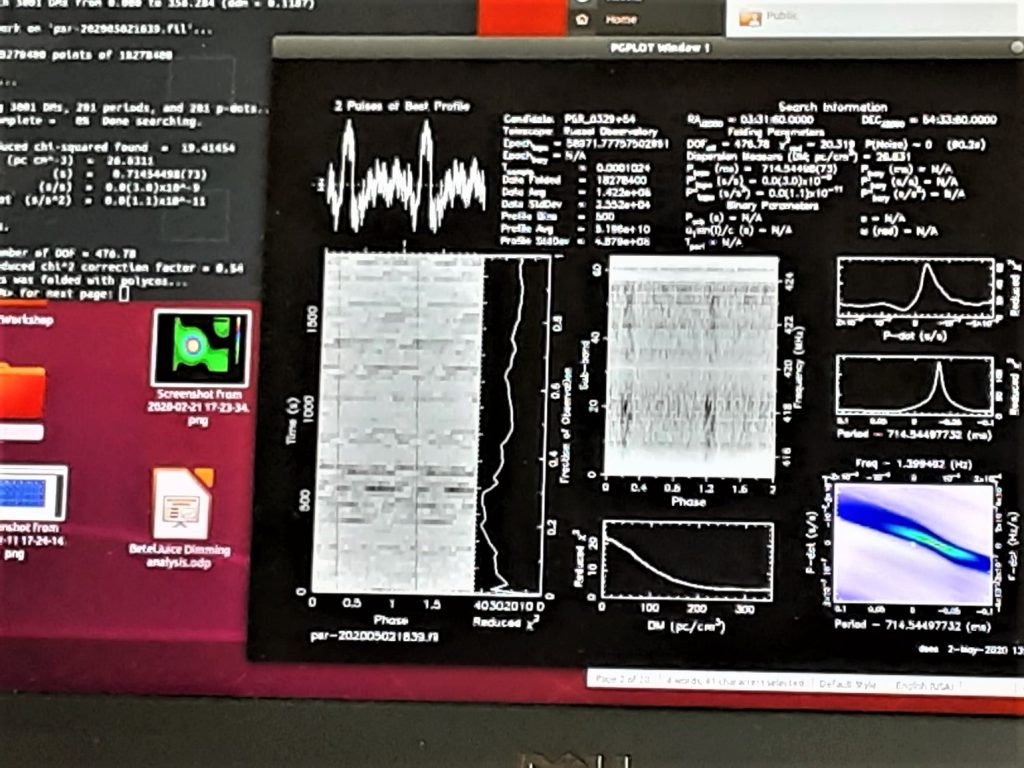
After some more iterations the final picture looked cleaner.

More analysis using the resultant data files allowed us to verify the pulsar as B0329+54 (J0332+5434).

Even the pulse width at the 50% height (W50) was estimated. The preliminary analysis below shows a measured W50 of 6 ms. The current value in the ATNF database is 6.6 ms. This is real close and confirms our observation.
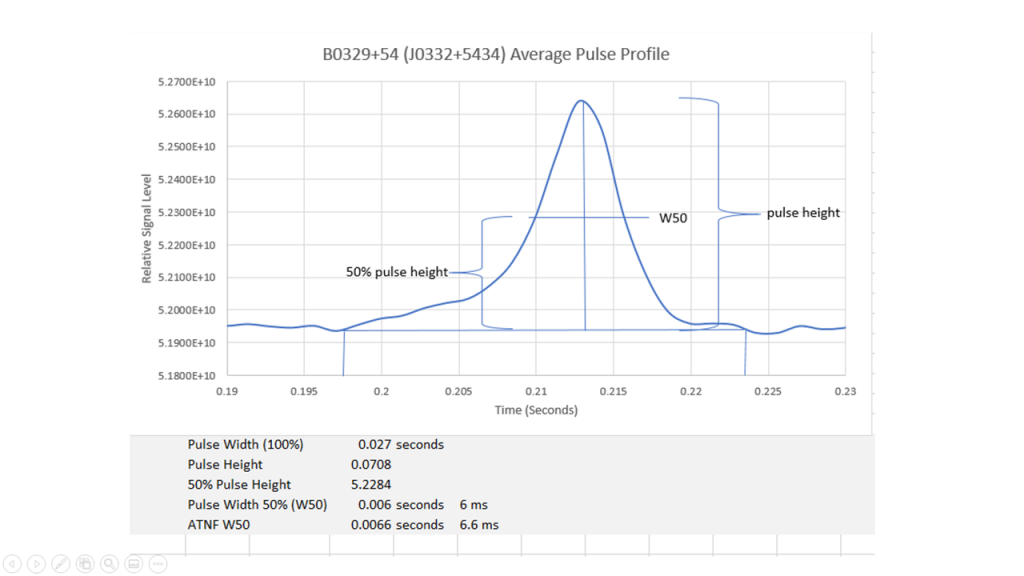
More observation runs are planned and DSES can can consider itself one of the few amateur organizations to accomplish pulsar observations2.

Reference:
- PSR B0329+54 is a pulsar approximately 3,460 light-years away in the constellation of Camelopardalis. It completes one rotation every 0.71452 seconds and is approximately 5 million years old.[Ref: wikipedia]
- Our successful observation is reported in Neutron Star Group http://neutronstar.joataman.net/
